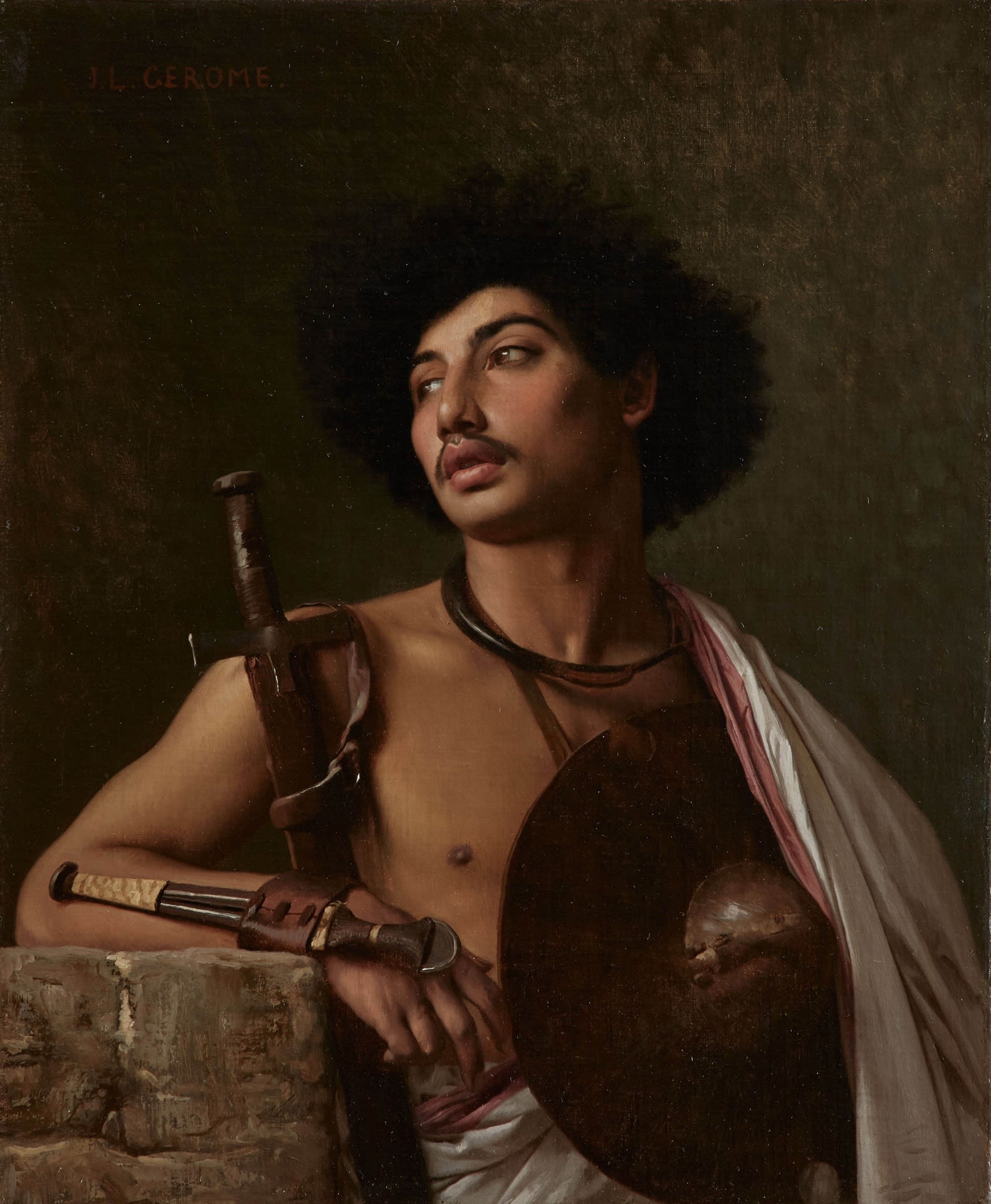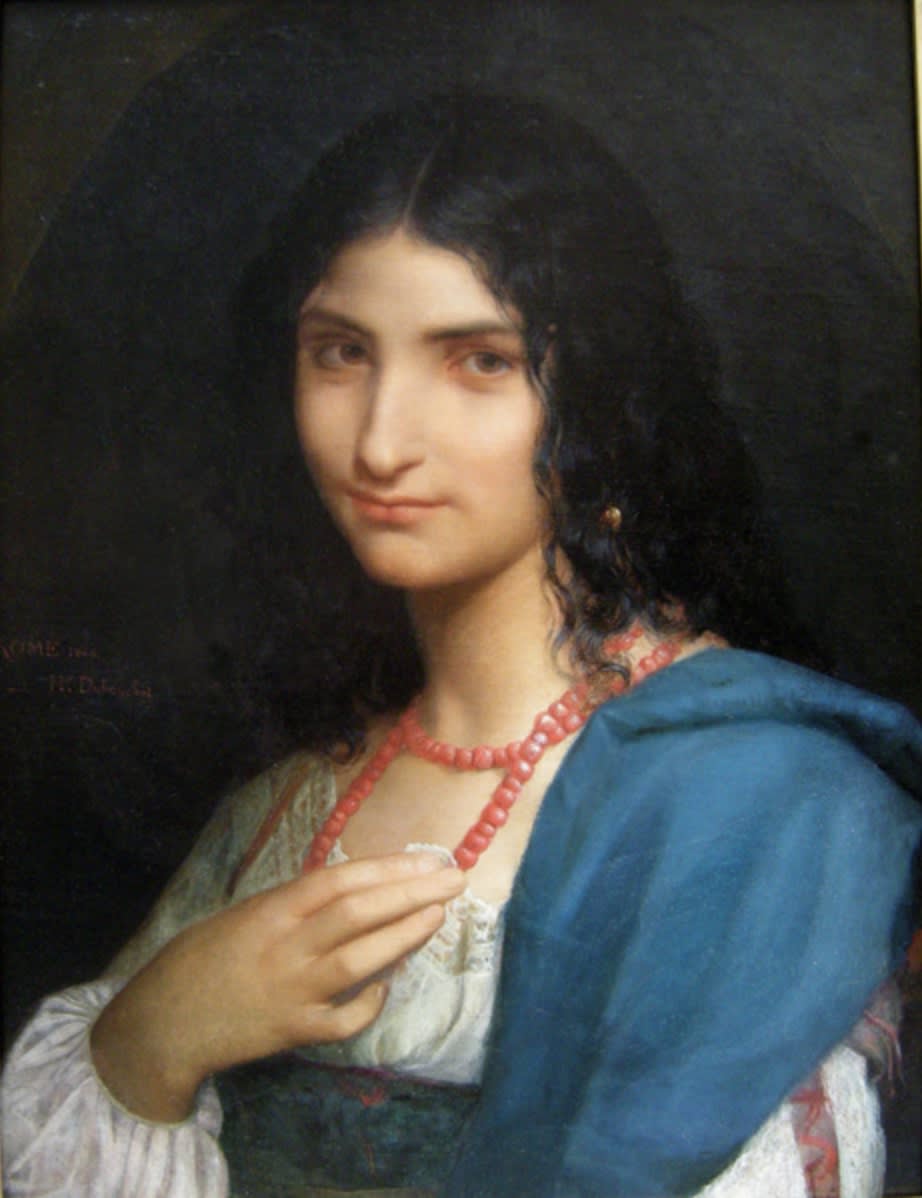Henri-Joseph Dubouchet (1833 – 1909)
Portrait of a man (Bohêmien)
Signed lower right: HJ. Dubouchet
Oil on canvas
56.2 x 43.8 cm. (22 x 17 ¼ in.)
Exhibited:
Portrait of a man (Bohêmien)
Signed lower right: HJ. Dubouchet
Oil on canvas
56.2 x 43.8 cm. (22 x 17 ¼ in.)
Exhibited:
L’Exposition de la Société des Amis des Art de Lyon, 1875-1876.
This direct and striking portrait of a young man by the Lyonnais artist Henri-Joseph Dubouchet is most interesting for its connection to Jean-Léon Gérôme’s two sensual depictions of a Bishari, nomads from the Nubian Desert (figs 1). With his full and fleshy lips, downy moustache, long, straight nose, heavy-lidded almond eyes and mane of black, curly hair, Dubouchet’s sitter is unmistakably the same man employed by Gérôme in 1872. Dubouchet’s picture, which was exhibited in Lyon in 1875-76, must date from around the same time.

Fig. 1, Jean-Leon Gérôme, Bishari Warrior, 1872, oil on canvas,
41 x 33 cm, Currier Museum of Art
The model’s identity is unknown but Gérôme must have already had him mind when he received the Bishari commission from the American art dealer Samuel P. Avery in 1871. Gérôme was at that time staying with Avery in London, avoiding the depredations caused by the ongoing Siege of Paris, yet waited until his return to France the following year to embark upon these works. Though it has not been posited before, this man also clearly served as the model for the gladiator pleading for mercy in Gérôme’s monumental Pollice Verso . The painting was begun in 1869, when Gérôme presumably first encountered the model. Perhaps he was a professional, and appears in other paintings from this time, beyond Gérôme and Dubouchet’s works.
Dubouchet, unlike Gérôme, portrays his sitter with no added accoutrements. Exquisite in its simplicity, all attention is focussed on the sitter’s highly distinctive countenance. When Dubouchet exhibited his painting in Lyon, he did so under the title ‘Bohémien’. Though by the 1870s the term bohémien had usually come to mean a literary or artistic outsider living in an unconventional way, it was derived, and still associated with, the roving Romani people who were mistakenly believed to have come to France from Bohemia. With his uncommon looks, and cloak slung around the shoulders in a vagabondic style, it is no doubt in this latter guise that Dubouchet has posed his model.
One day a Bishari, the next a Bohemian, and in between a gladiator, Dubouchet’s unknown sitter is proof of the fluid identities professional models could obtain in their artistic roles in France at this period. Hopefully the model’s name, no doubt listed somewhere in French archives, may someday emerge.

Fig. 2, Henri-Joseph Dubouchet, Roman woman, 1868, oil on canvas,
43 x 55 cm, Private Collection
Dubouchet studied at the École des beaux-arts de Lyon under Victor Vibert. In 1856 the young artist finished second in the prix de Rome for engraving and it is for this activity that Dubouchet is best remembered, despite the fact that he was a talented painter as the present work, and others like it (fig. 2), attests. He visited Italy in the late 1860s and exhibited regularly in both Paris and Lyon from the mid-1850s until
